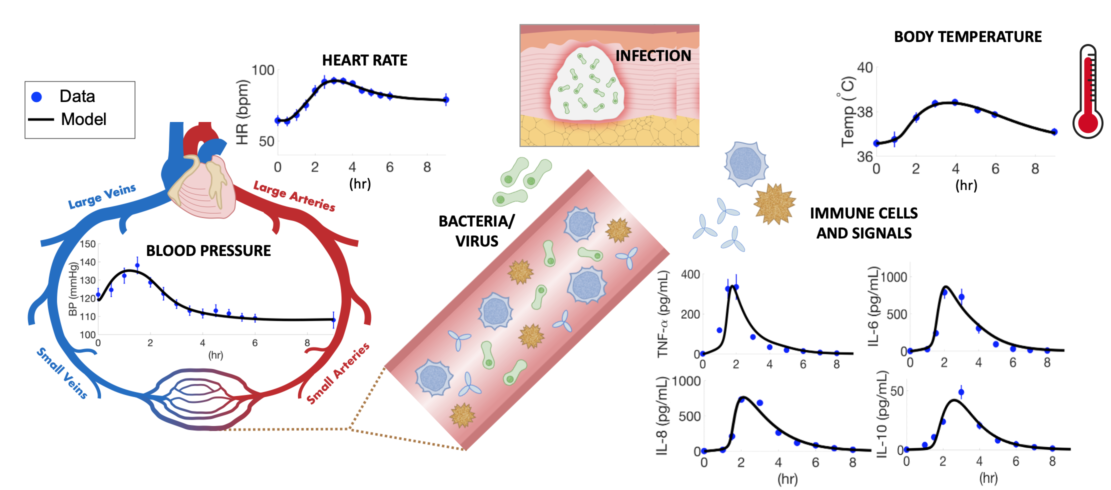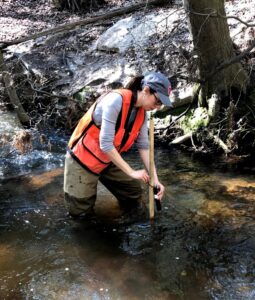Postdoc Research Spotlight: College of Sciences
Highlighting Postdoc Research from the College of Sciences
 Atanaska Dobreva, Ph.D.
Atanaska Dobreva, Ph.D.
Postdoc in Mathematics
Using mathematical models to understand the body’s response to infection
Research Blurb:
In my research, I use mathematical modeling and analysis to investigate immune system conditions and how they impact physiological functions such as cardiovascular dynamics, vision, and hair growth. I explore the life-threatening condition sepsis as a case study for how an immune response that is out of balance affects body temperature, heart rate and blood pressure. Sepsis is characterized by an excessive inflammatory reaction to infection, which leads to vascular failure, resulting in severe damage of major organs. Sepsis is among the leading causes of death worldwide, and each year it affects close to 2 million people in the US. The situation is likely to worsen due to the public health threat from drug resistant bacteria and viruses and the emergence of novel viruses, such as COVID-19. Treating the condition is difficult and creates significant financial burden for healthcare systems. To study sepsis, I develop a mathematical model by setting up equations that describe how different parts of the immune system communicate with body temperature and with the circulatory system, responsible for controlling blood pressure and heart rate. The model is calibrated with experimental data measured in humans and can be used to forecast a range of patient responses based on individual immune characteristics and infection severity as well as to test various therapeutic strategies. My research is important because it contributes to a deeper understanding of how sepsis develops and how to treat it.

Key Finding:
Using the mathematical model to explore different therapeutic interventions, I found that the most favorable recuperation results are achieved by combining more than one method of treatment in order to simultaneously remove the bacterium or virus from the body and alleviate symptoms caused by the immune system as it fights the infection.
Research Impact:
My hope is that my research can help in the discovery of novel methods for early detection and treatment of sepsis in order to significantly improve recovery outcomes for sepsis patients all over the world.
Delve Deeper: arXiv Preprint Publication
Connect with Atanaska: Personal Website
 Marie-Amelie Petre, Ph.D.
Marie-Amelie Petre, Ph.D.
Postdoc in Marine, Earth, & Atmospheric Sciences
Understanding the longevity of chemical contaminants in groundwater
Research Blurb:
My current research focuses on PFAS contamination in groundwater near a chemical plant in Fayetteville, along the Cape Fear River. PFAS chemicals are persistent in the environment and are linked to multiple adverse health effects. The PFAS crisis in the Cape Fear River watershed is the worst PFAS contamination problem in North Carolina as over 3200 water supply wells are contaminated within a 16 km radius of the chemical plant, and release of PFAS has contaminated the Cape Fear River, a drinking water supply for about 250,000 people in downriver communities. Even though the plant stopped directly discharging wastewater to the Cape Fear River in November 2017, ongoing discharge of contaminated groundwater into the river and its tributary streams could have a long-term impact on the use of the river for drinking water supply.
My goal is to determine 1) how fast these contaminants come out of the ground and into the streams and 2) how long it will take for PFAS to flush out of the groundwater system. These questions are particularly relevant to residents who own a water well in the Fayetteville area, as well as the water managers in the downstream communities in Wilmington who rely on surface water for their water supply.
We collect field data to quantify the water and PFAS fluxes at the surface water-groundwater interface, and use environmental tracers to determine the age of groundwater. We investigated five tributary watersheds of the Cape Fear River near the chemical plant.

Key Finding:
We found that PFAS contamination in groundwater was widespread around the chemical plant and that 22-25 kg/yr of PFAS discharged from groundwater to Georgia Branch, one of tributary streams of the Cape Fear River. For perspective, the PFAS discharge from groundwater to this small tributary stream is larger than the estimated PFAS output from all landfills in NC combined.
Research Impact:
I hope this project will support management decisions regarding the remediation of contaminated water or the infrastructure and costs needed to treat contaminated water. Our research should also benefit downstream communities by providing guidance on how long advanced treatment may be needed to continue using the river as a water supply. Also, quantifying the PFAS discharge from groundwater to the river can be useful in forecasting downriver PFAS concentrations.
- Categories:


